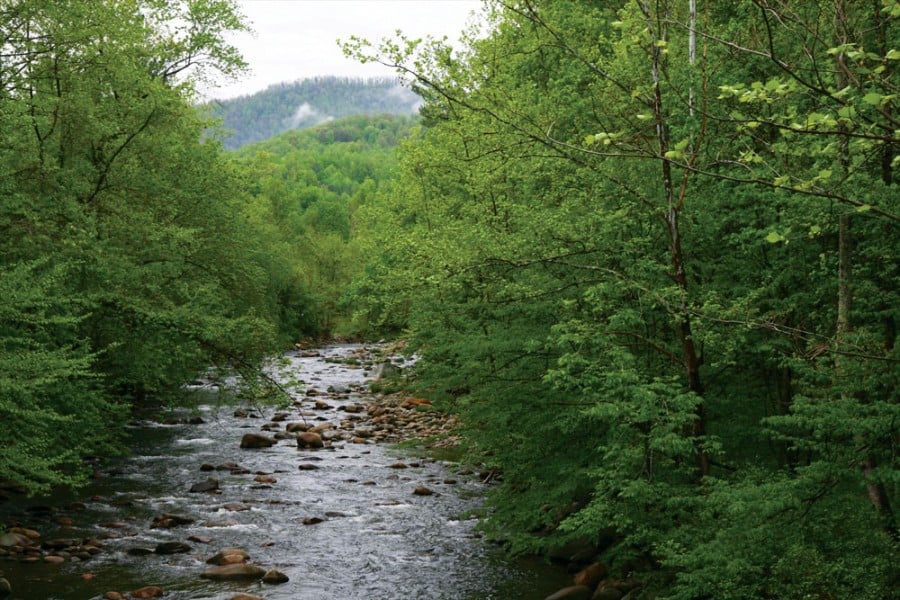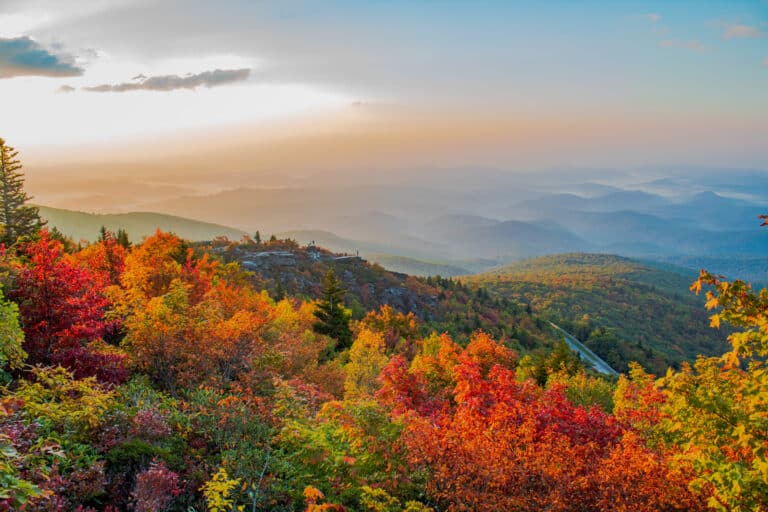As we mark the 20th anniversary of Blue Ridge Outdoors, it’s time to celebrate some major successes in protecting human health and the environment in our region, resulting from the tireless efforts of public interest groups and thousands of concerned citizens. At the same time, we’d be remiss to ignore the substantial work yet to be done. Here, then, is a rundown of several significant environmental milestones in Appalachia—both successes and setbacks—over the past two decades.
Southern Appalachian national forests saved.
Almost five million acres of national forest from Virginia to Alabama offer some of the best recreational opportunities in the East, protect drinking water, shelter a wide variety of fish and wildlife, and pump millions of dollars into local economies. We are happy to report that a sizable chunk of this precious resource has been protected. Expanded wilderness areas, improvements to long-term forest management plans, and halts to clear cutting have helped. So has inclusion of 725,000 acres of roadless areas in the Roadless Area Conservation Rule, after the U.S. Supreme Court allowed the rule to stand in 2012.
“The roadless areas in our national forests represent an essential part of America’s natural heritage,” said Southern Environmental Law Center General Counsel David Carr. “Permanently protecting them ensures that they will remain healthy and whole to be enjoyed by current and future generations.”
Amid the onslaught of misguided road-building proposals, excessive use of off-road vehicles, and, of course, continuous pressure from industry to drill, baby, drill, victories like this will help preserve increasingly rare hardwood forests and myriad other natural resources.
Pointless, destructive road through Smokies Stopped.
Powerful forces in Swain County, N.C., lobbied hard for decades to build a road straight through the wildest area of Great Smoky Mountain National Park. But in the end, reason and respect for the earth prevailed.
It all started when another county road was flooded in the 1940s to create Fontana Lake. In the 1960s, the National Park Service started to build a replacement. The project was abandoned on economic and environmental grounds, but apparently that didn’t matter to some county residents, who wanted a road no matter what.
Thankfully, in February 2010, a settlement was reached to halt construction permanently. Swain County got $52 million out of the deal, and environmentalists were thrilled because the proposed road would have lacerated the largest unbroken, federally owned forest in the East. Vital habitat for rare birds, bears, and fish—not to mention the wilderness character of that section of the park—would have evaporated.
“Stopping this ‘road to nowhere’ was a significant victory for all who treasure the beauty of this region, and it protected one of the most breathtaking areas in the Smokies,” said D.J. Gerken, managing attorney in SELC’s Asheville Office.
Wilderness Bill Saves Jefferson National Forest.
In March 2009, U.S. legislators approved the largest piece of wilderness legislation the Southern Appalachians have seen in a decade. The Virginia Ridge and Valley Act ensures that more than 53,000 acres of the Jefferson National Forest will remain forever wild by establishing six new wilderness areas and expanding several others. It also designated a wilderness study area and two new national scenic areas. It helped that the bill had a lot of fans, including religious, tourism, and recreation groups, state and local governments, businesses, and, of course, conservationists.
Bills like this are sorely needed. For example, according to the SELC, in Virginia just 177,214 acres—less than one percent of the state—are congressionally designated wilderness. By contrast, a 1999 U.S. Forest Service study found that in 2050, demand for wilderness recreation opportunities will have soared by 171 percent. Numbers like these eviscerate the claim that there’s too much useless wilderness out there. One percent is too much? Really?
Proposed new coal plants defeated; existing plants retired.
Although King Coal might appear to be invincible, he most assuredly is not. Consider, for example, the significant number of new coal plants that were stopped or scrapped throughout the region in the past 20 years. The proposed 1500-megawatt coal plant for Surry County, Va., is one. This smog-belching monstrosity, which the Old Dominion Electric Company was persuaded not to build after a massive public outcry, would have torched about 9,000 tons of southern Appalachian coal—much of it from devastating mountaintop removal mines—every single day. Instead, tons of carbon dioxide and other pollutants will be kept out of the atmosphere and peoples’ lungs. Victories like these have prevented untold air and water pollution in the Southeast, which, as a region, remains one of world’s largest contributors to climate change. That’s why environmental groups are still working to convince utilities that it’s time to retire aging coal plants and invest in cleaner technologies. It’s an uphill slog, to be sure, but there’s arguably no greater environmental priority in Appalachia.
Major gains made in renewables, especially solar.
To hear industry apologists tell it, renewable energy is, and always will be, a pipe dream. You’ve heard the refrain: Renewables are too expensive, plus the sun doesn’t always shine and the wind doesn’t always blow, so let’s just cut our losses and keep choking on coal dust.
But the challenges that come with renewables aren’t the show-stoppers they once were. Solar alone could easily supply a good portion of Appalachia’s energy needs if we would stop subsidizing Big Oil and build a solid renewable energy infrastructure.
Not only has the cost of solar panels plummeted some 400 percent in just the past few years, but the intermittent nature of many renewables is no longer a big deal thanks to a host of new energy storage technologies, including higher-capacity, longer-lasting batteries, compressed air systems, and hydroelectric pumps. We’ve come so far that a Delaware-sized area would be enough to power the entire country using solar-concentrated power plants.
So it’s now a question of public policy, not technology, and that’s why we need politicians who aren’t beholden to the petrochemical industrial complex. “If you look at Europe, especially Germany, they create policies that create good energy systems,” says Jeff Deal, senior project manager at the Appalachian Institute for Renewable Energy. “There’s no question that it’s a policy issue, not a feasibility issue.”
Tennessee Wilderness still in jeopardy.
The vast area known as the Cherokee National Forest in east Tennessee exemplifies our continuing struggle against those who would destroy our last wild places for dubious short-term gain. According to SELC, this national treasure comprises some 640,000 mountainous acres sheltering a huge variety of wildlife in diverse forest habitats, including 43 species of mammals, 55 species of reptiles and amphibians, dozens of bird species, and some of the region’s largest quantities of native brook trout. The Appalachian Trail and Benton MacKaye Trail wind through here, too, which makes the area a bucket-list destination for legions of hikers every year.
Unfortunately, only about 10 percent of the Cherokee National Forest is officially designated as wilderness. That leaves it vulnerable to logging, mining, fracking, road building, and other indignities. A coalition called Tennessee Wild is trying to stem the tide of exploitation by promoting a bill that would designate almost 20,000 additional acres of the forest as wilderness. It needs all the support it can get—meaning yours.
Mountaintop removal mining remains a scourge.
Blowing up mountains to extract the coal from within may be relatively cheap and easy, but it’s been an unmitigated disaster for those unfortunates who happen to live near the resulting scars in the earth. Toxic chemicals and sediment leaching from open-pit mines flow directly into once-pristine waterways that provide vital drinking water and animal habitats. People and animals are poisoned, sometimes severely. Fish die in droves.
The so-called mitigation efforts trumpeted by industry aren’t working very well, either. For example, one recent study found there are more streams damaged or destroyed from mining than “restored,” and even the restored streams don’t function like they used to and wouldn’t pass a reasonable environmental assessment.
The bottom line: mountaintop removal mining has decimated more than 500 of the oldest, most biologically rich mountains in America, along with more than 2,000 miles of headwater streams. It has also destoryed countless communities and degraded human health across Appalachia.
For the time being, market forces are beginning to stem the tide as Appalachian coal gets more expensive compared to Western coal and natural gas. “Those two things are sort of out-competing mountaintop removal coal from Appalachia,” says Eric Chance, spokesperson for Appalachian Voices. The bad news is that markets are, of course, cyclical, and coal could be cheap again before we know it.
GW National Forest partly opened to drilling.
Last November, the Forest Service released a new long-term management plan opening 177,000 acres of the George Washington National Forest to fracking. It’s not an unmitigated disaster, considering the GW contains some 1.1 million acres, the vast majority of which remain protected. Indeed, two new wilderness areas are proposed, others will be will be expanded, and a new recreation area will be added. And the draft management plan released three years ago would have opened most of the forest to vertical drilling.
But the final plan sets an unwelcome precedent and helps perpetuate this country’s seemingly unending addiction to fossil fuels. “We think our public lands should be preserved for the public good,” Chance says. “There are still a lot of unknowns regarding the long-term consequences of fracking.”
And more than just those 177,000 acres are at stake; fracking requires an extensive infrastructure that will diminish the wilderness character of the rest of the forest, and fishing, paddling, and other recreational activities—not to mention drinking water supplies—could be threatened. The GW is the largest national forest in the East with more than one million visitors annually. Millions more living downstream depend on its protected drinking water supplies. The government should have said no to fracking, period.
So there you have it: some significant achievements, to be sure, but storm clouds loom. That’s where you come in. Apathy will guarantee that our environmental successes are swallowed by a host of atrocities perpetrated by those who view the natural world as their personal ATM. So get off the couch and do something. Volunteer, donate, write your congressional representative—whatever you can. Together, let’s make the next 20 years even better than the last and leave a legacy for our children that we can be proud of and they will cherish.








